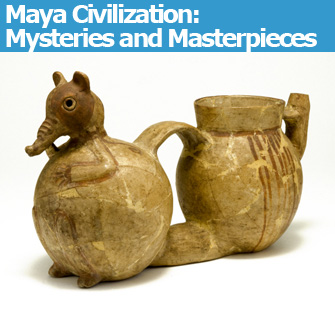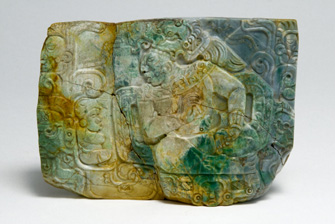 |
|
A whistling vase (250-550) from Kaminaljuyu. Photo © Ricky Lopez Bruni |
The mystery of the collapse of the Maya civilization has never been satisfactorily explained – was it caused by internal warfare, invasion, environmental …
 |
|
A whistling vase (250-550) from Kaminaljuyu. Photo © Ricky Lopez Bruni |
The mystery of the collapse of the Maya civilization has never been satisfactorily explained – was it caused by internal warfare, invasion, environmental disasters, epidemics, famine, drought, overpopulation? While the experts continue to argue, we can still enjoy some of the fruits of this highly sophisticated civilization in a new exhibition, “Maya: From Dawn to Dusk,” at the Musée du Quai Branly. Most of the 160 artifacts from different archaeological sites on show, which come from the Museo Nacional de Arqueología y Etnología du Guatemala, have never before been seen outside of Guatemala.
The show traces the country’s Maya civilization from the pre-classic (2000 B.C.E.-150 C.E.) to the classic (250-900) and post-classic (1000-1524) periods. Masterpiece after masterpiece exhibits an incredible variety of forms and imagery and a high level of craftsmanship, attesting to the extreme sophistication of one of the five civilizations in the world to develop a complete writing system and the only one in the pre-Columbian Americas. The Maya also developed the concept of zero and were the first to use it in mathematical calculations. They perfected a highly accurate calendar, a complex cosmology (they could predict an eclipse within a range of seven minutes over a period of 32 years) and a layered social hierarchy, and were accomplished architects, builders and traders.
Early pieces on show here include a mushroom-headed animal in volcanic rock (2000 B.C.E.-800 C.E.) and a stunning simple greenstone vase (400 B.C.E.-100 C.E.) from Kaminaljuyu. From a later period in Tikal, a ceramic platter (100-250), decorated with images of six frogs and a geometric band, rests on four breast-shaped legs, like a few other pieces in the exhibition. Also from Tikal is a covered bowl (250-550) whose handle represents the head of a jaguar, while the rest of his body is painted on the cover, yet another fine example of the artistic imagination of Maya artisans.
Alongside a couple of pieces of sumptuous jade jewelry is a beautifully carved jade plaque
 |
|
Jade plaque (550-800) from Nebaj. Photo © Ricky Lopez Bruni |
(Nebaj, 550-800) showing a royal personage sitting on a throne leaning forward and talking with a dwarf. Nearby are musical instruments: drums, a flute, an ocarina. There are also many adorable animal-shaped containers with double bodies that acted as whistles – blowing on the chocolate drink (another great Maya contribution, which was used as currency) contained in the bowl on one side produced a whistling sound. Among the weapons on display are some “eccentrics,” elaborately carved pieces used only for show. Also from the classic period, when the civilization was at its apogee, we see stones neatly engraved with glyphs recounting a trip taken by a king. A film explains how the Maya calendar works.
I had the luck to be at the Musée du Quai Branly when archaeologist Richard D. Hansen, scientific advisor to the show, was taking visitors around the exhibition. He provided details and told stories about many artifacts: how the whistles worked, for example, or what a boy pictured on an engraved stele is doing: piercing his penis with a stingray spine in an act of autosacrifice, or bloodletting; the drops of blood fall from it onto a piece of paper, which would have then been burned as an offering to the gods. It is a shame that the museum does not put this kind of information, which is so fascinating for visitors, on the labels accompanying the objects.
Another film shows Hansen giving an on-site tour of the El Mirador pyramid, which he is in charge of excavating. He has, by the way, solved the mystery of the collapse of this particular Maya site (around 150 B.C.E.) by proving that the cause in this case was deforestation.
The exhibition ends with photos and films by Ricky Lopez showing how some Maya traditions live on today in Guatemala.
Musée du Quai Branly: 37, quai Branly, 75007 Paris. Métro: Iéna, Alma-Marceau or Bir Hakeim. RER Pont de l’Alma. Tel.: 01 56 61 70 00. Open Tuesday, Wednesday and Sunday 11 a.m.-7 p.m.; Thursday-Saturday, 11 a.m.-9 p.m. Admission: €7. Through October 2. www.quaibranly.fr
Reader Reaction: Click here to respond to this article (your response may be published on this page and is subject to editing).
Please support Paris Update by ordering books from Paris Update’s Amazon store at no extra cost. Click on your preferred Amazon location: U.K., France, U.S.
More reviews of Paris art shows.
© 2011 Paris Update
